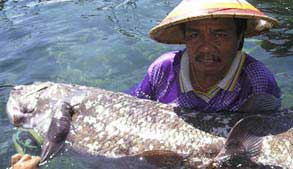New Indonesia Coelacanth Caught
Posted by: Loren Coleman on May 21st, 2007
Fisherman in Indonesia nets rare, ancient coelacanth fish
The China Post
2007/5/22
Manado, Indonesia, Reuters

An Indonesian fisherman has caught a coelacanth, an ancient fish once thought to have become extinct at the time of the dinosaurs, a fishery expert said on Monday.
Yustinus Lahama and his son caught the fish on Saturday in the sea off North Sulawesi province and kept it at their house for an hour, said Grevo Gerung, a professor at the fisheries faculty at the Sam Ratulangi University.
After being told by neighbors it was a rare fish he took it back to the sea and kept it in a quarantine pool for about 17 hours before it died.
“If kept outside their habitat (60 meters or 200 feet below the sea), the fish can only live for two hours. But this fish lived for about 17 hours,” Gerung told Reuters.
“We will look into why it had lived that long,” he said.
The fish was 131 centimeters (about four feet) long and weighed 51 kg (112 lb), Gerung said.
In 1998, fishermen a caught another coelacanth in a deep-water shark net off northern Sulawesi.
That catch came 60 years after a member of the species was rediscovered on the east coast of South Africa.
Coelacanths are known from the fossil records dating back more than 360 million years, according to the Australian Museum Fish Web site.
Before 1938 they were believed to have become extinct approximately 80 million years ago, when they disappeared from the fossil record, it said.
Coelacanths are the only living animals to have a fully functional intercranial joint, which is a division separating the ear and brain from the nasal organs and eye.
About Loren Coleman
Loren Coleman is one of the world’s leading cryptozoologists, some say “the” leading living cryptozoologist. Certainly, he is acknowledged as the current living American researcher and writer who has most popularized cryptozoology in the late 20th and early 21st centuries.
Starting his fieldwork and investigations in 1960, after traveling and trekking extensively in pursuit of cryptozoological mysteries, Coleman began writing to share his experiences in 1969. An honorary member of Ivan T. Sanderson’s Society for the Investigation of the Unexplained in the 1970s, Coleman has been bestowed with similar honorary memberships of the North Idaho College Cryptozoology Club in 1983, and in subsequent years, that of the British Columbia Scientific Cryptozoology Club, CryptoSafari International, and other international organizations. He was also a Life Member and Benefactor of the International Society of Cryptozoology (now-defunct).
Loren Coleman’s daily blog, as a member of the Cryptomundo Team, served as an ongoing avenue of communication for the ever-growing body of cryptozoo news from 2005 through 2013. He returned as an infrequent contributor beginning Halloween week of 2015.
Coleman is the founder in 2003, and current director of the International Cryptozoology Museum in Portland, Maine.










It was a crime to kill this fish. It must be protected, a no fishing ban on this species. It must be well publicized. If caught it must released.
The gradual discovery of multiple coelacanth specimens — over thousands of miles of deep, trackless ocean — is an example of what needs to happen with Bigfoot, Nessie, and other more-or-less landlocked cryptids.
However, a mystery is often more appealing than its reality.
Cool. Find more.
See, an animal can “dissappear” from the fossil record, but still exist.
Seems to me it would die if caught and released anyway. It most likely would bloat like sea bass and link cod when brought up from the depths. Don’t certain fish do that when brought up from deep water too fast?
The issue of releasing the fish alive is not that difficult to overcome, the reason that a fish may not live when brought up from the high pressure depths is that its swim bladder which is usually compressed by the pressure expands and fills with gas which adds buoyancy and the fish cannot swim back down because it floats. A small incision in the side rear flank of the fish punctures the bladder releasing the gas and the fish is able to re-submerge; the puncture is actually very small and does not harm the fish to the point that it kills it in most circumstances, where the fish would certainly die when it could not re-submerge.
Bob Michaels, these fishermen in the area that the Coelacanth was caught are not biologists, and information travels slowly in that part of the world when you are not a multi-million $ a year household, most have no formal education, instead of criticizing them, hop a plane, take all of your knowledge and money and educate them.
Great find!!! Now we just have to put it on the endangered species list!